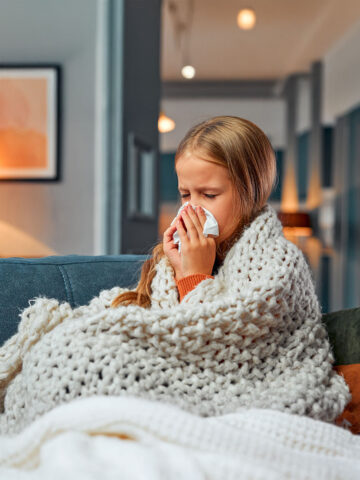Signs, symptoms and treatment for muscle strains and sprains, and broken bones
In many active kids and teens, common injuries include muscle strains, muscle sprains and broken bones caused by participating in sports, exercising and playing.
Strains, sprains and broken bones have many similar signs and symptoms while causing similar amounts of pain. Because of this, parents may have a hard time determining which injury their child has and how to best help them.
Here, CHOC experts explain the causes, symptoms and treatment for sprains, strains and broken bones.
Muscle strains in children and teens
What is a strain?
A strain is when a muscle or tendon (tissue that attaches muscle to bone) is stretched too far. A strain is sometimes called a “pulled muscle.” Depending on the level of muscle strain, it may heal within a few weeks, but reinjury can happen.
What are the signs and symptoms of strains?
Strains and sprains can cause:
- Pain, either at the time of injury or later.
- Tenderness in the soft tissue, usually close to the bone.
- Swelling.
- Bruising.
- Muscle spasms.
- Weakness or pain when using or moving the injured area.
What causes strains?
Strains can happen when you put a lot of pressure on a muscle or push it too far, such as when lifting a heavy object. They usually happen when someone is active, contracting, stretching or working out a body part. They’re more likely when a person hasn’t warmed up first to get blood circulating to the muscles. Strains are common when athletes return to a sport after the off-season.
The following are two common strains:
- Back strain. This happens when the muscles that support the spine are twisted, pulled, or torn. Athletes who engage in excessive jumping or twisting — like during basketball or volleyball — are at risk for back strains.
- Hamstring muscle strain. This is when the hamstring, or the major muscle in the back of the thigh, tears or stretches. An imbalance in strength between the hamstrings and the quadriceps can cause a strain. Kicking a football, running, or leaping to make a basket can pull a hamstring. Once a hamstring is pulled, it tends to happen again.
Learn more about sprains and strains from CHOC experts.
Muscle sprains in children and teens
What is a sprain?
A sprain is when ligaments (bands of tissue that hold bone to bone at the joints) stretch too far or tear. A sprain may take four to six weeks to heal — or sometimes longer.
The ankle is the most sprained joint. Sprained ankles are more likely in children or teens who have had them in the past.
Learn more about signs, symptoms and treatments for sprained ankles.
What are the signs and symptoms of a sprain?
You may feel a tear or pop in the joint. Although the sprain’s intensity may vary, all sprains commonly cause the following:
- Pain.
- Swelling.
- Bruising.
- Muscle spasms.
- Weakness or pain when using or moving the injured area.
What causes sprains in children and teens?
Sprains are caused by injuries, such as twisting an ankle or knee, or from contact with another player. They’re common in sports but can happen any time.
Sprains and strains diagnosis, treatment and recovery for children and teens
How are sprains and strains diagnosed?
To diagnose strains and sprains, doctors:
- Ask questions about the injured body part.
- Do an exam, observe range of motion and ask the child to perform strength tests.
Depending on the injury, the doctor may order an X-ray or other imaging study to see if there are other injuries, such as a broken bone. Ultrasounds can sometimes diagnose a minor tear.
How are strains and sprains treated?
Treatment for strains and sprains usually includes:
- Rest, which is the key to recovery and preventing re-injury.
- Immediate treatments to help with swelling, such as:
- Ice wrapped in a towel placed on the area for about 20 minutes every 1–2 hours.
- An elastic bandage wrapped around the area for compression or a compression sleeve.
- Raising the injured area.
- Immobilizing the affected area right away and keeping it still for a few days.
- Warm compresses or a heating pad (after the swelling goes down).
- Strengthening exercises, especially eccentric strengthening exercises (movements that lengthen muscles).
- Pain medicine for no more than one week.
Doctors may treat some strains and sprains and strains with a splint or temporary cast.
Can a child or teen with a sprain or strain play sports?
If your child has a sprain or strain, they’ll probably need to take some time off from sports. They can go back when:
- The swelling goes down.
- The sport does not cause pain.
- The doctor says it’s OK.
- They can participate without a limp.
- They have their full range of motion.
- They are back to full strength.
What else should I know about sprains and strains for children and teens?
Strains and sprains usually heal without any lasting problems. Be sure to follow the doctor’s instructions so the injury heals as quickly as possible.
To avoid strains and sprains, make sure your kids are doing a good dynamic warm-up before am activity. They can try jogging, high knees, butt kicks, and active stretching. After an activity, encourage some static stretching (holding each stretch for 30 seconds or longer).
A coach, personal trainer, doctor, or physical therapist can show your child how to do eccentric strengthening exercises to help with recovery and lower the risk of reinjury.
Broken bones (fractures) in children and teens
What is a broken bone?
A broken bone, also called a fracture, is when a break goes through part or all of a bone.
What are the kinds of broken bones?
Types of bone fractures include:
- Avulsion fracture: when a tendon or ligament pulls off of a tiny piece of bone.
- Growth plate fracture: a break in the area of a growing bone.
- Stress fracture: a tiny crack in the bone.
- Comminuted fracture: a bone breaks into more than two pieces.
- Compression fracture: a collapsing of the bone.
Kids’ bones are more likely to bend than break completely because they’re softer. Fracture types that are more common in kids include:
- Greenstick fracture: a break on one side of the bone only.
- Buckle or torus fracture: an outward bend on one side of the bone without breaking the other side.
How causes a broken bone?
Common causes of broken bones in teens include falls, accidents and sports mishaps.
What are the signs and symptoms of a broken bone?
The signs of a fracture depend on the type of break and the bone affected. It always hurts to break a bone. There also might be swelling and bruising. The injured area may be hard to move and use.
Sometimes there’s a deformity — this means that the body part looks crooked or different than it did before the injury.
A CHOC orthopedic surgeon talks more about broken bones.
How are broken bones diagnosed and treated?
Doctors order X-rays if they think a bone is broken. An X-ray usually can show if there is a break, where it is and the type of break.
Doctors treat most broken bones with a cast, splint or brace. This keeps the broken bone from moving while it heals. Even broken bones that don’t line up (called displaced) often will heal straight over time.
Sometimes the displaced bones are put back in place before the cast, splint, or brace is put on. This is done through a procedure called a reduction. This is also called “setting the bone.”
The two types of reductions are:
A closed reduction. This is done in the emergency room or operating room after the person gets medicine to ease the pain. The surgeon moves the bones back into the right position. No incision (cut) is needed.
An open reduction. This surgery is done for a more complicated injury. It happens in the operating room under general anesthesia. The surgeon makes a cut and moves the bones into the right position. Surgical plates, screws or wires might keep the bones in place.
How do broken bones heal?
The first few days after a fracture, the body forms a blood clot (or hematoma) around the broken bone. This protects the bone and delivers the cells needed for healing.
Then, an area of healing tissue forms around the broken bone. This is called a callus. It joins the broken bones together. It’s soft at first, then gets harder and stronger over the following weeks.
New bone forms in the weeks to months after a break, but full healing can take longer.
How can my child feel better after breaking a bone?
As your child recovers from a broken bone, make sure they:
- Eat a healthy diet that includes plenty of calcium and vitamin D.
- Take good care of the cast or splint.
- Follow the health care provider’s directions for rest and/or doing any exercises.
- Go to all follow-up appointments.
Broken bones are a common injury. With the right treatment, a broken bone usually heals well. Follow your health care provider’s recommendations, and soon your child will be back to all the activities they did before the injury.
Visit CHOC’s Fracture Clinic page to learn more about broken bones.
Get more expert health advice delivered to your inbox monthly by subscribing to the KidsHealth newsletter here.
Learn more about CHOC’s Orthopedic and Sports Medicine Services
Our team of board-certified specialists and orthopedics-trained staff provide a full spectrum of care for disorders of the bones, joints, ligaments, tendons and muscles.





